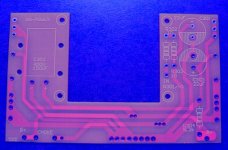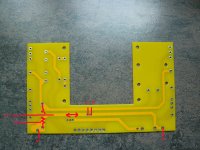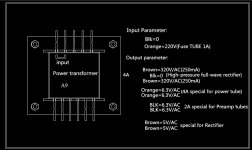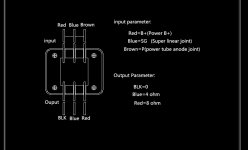OK. Pot wired correctly and pins 1-4 connected on triodes - and now I have a working amp! Albeit just the left channel at the moment. I'll check the right channel connections now and hopefully I'll have a stereo amp working soon! Very many thanks for all the expert help from you guys.
Hi Mike - I hope my problems are helping you! Is your point that I may have incorrect connections? There are connections on the other side of the board. It'll be difficult to lift it now that I've got all the resistors connected.
Hiya
It was just a thought as those 2 connections looked likely suspects for connection B1 from each of the output transformers. Pay no attention to my ramblings as I was just asking VictoriaGuy whether he thought that was what they were for.....since your amp is now working you have clearly got them connected ok.
Looking forward to your opinions on how it sounds once both channels are up and running and connected to good source.
OK. All working in stereo now. The problem with the non-working channel was a dry-joint on the input peg (difficult to get the solder to bind to the gold pin I find). Sound is good, very little hum and no real distortion at full volume. Sounds very warm. Thank you again to everyone.
Mike best wishes with your build.
Mike best wishes with your build.
Mike-Hiya VictoriaGuy
I have been reading this with interest as I have not started mine yet. Thought a couple of pics of the main power board might help with the fault finding.
Thanks! Just what I needed to answer my questions. Almost as good as having the PCB in my hands.
And, also thanks to Ygg-t for doing that combined photo.
OK. All working in stereo now. The problem with the non-working channel was a dry-joint on the input peg (difficult to get the solder to bind to the gold pin I find). Sound is good, very little hum and no real distortion at full volume. Sounds very warm. Thank you again to everyone.
Mike best wishes with your build.
I'm glad to hear that!
Congrats on 'sticking with it'!
From a very quick look at the schematic (and from a tube-noob's point of view) are the 2 connection points to C302 you have marked meant for connection of the o/p xfmr flying leads B1 ?
Yes, you have that worked out correctly.
There are two different pairs of solder points for the B1 connections-one pair close together at the end of that C302 trace on the top side of the board, the others are at the edge of the board; use either, IMO.
Checking the top and bottom of the board, you can figure out how the 4 connections to the + end of the 150uF cap are made:
Two connections to the primarys of the output transformers (B1 R and B1 L), one end of the choke, and one end of R304.
IMO, time spent working out this stuff before the board gets 'locked in place' with soldered connections is useful. Your pics of the board are an excellent resource.
For a simple circuit like this, terminal strips with good solder lugs can work well, but good ones are not that common these days, so the PCB can help.
(My kit from a few years ago didn't include PCBs.)
Mike- for your own build, a few hints:
'Spaghetti' or heat shrink on some component leads where necessary
Don't be afraid to trim the transformer leads, especially the PT ones as you don't want AC leads looping around.
Solid core hookup wire is easier to manage than stranded.
Attachments
Hi all. I've been listening to it for hours and there is some distortion. My source is currently a Squeezebox feeding from 320kbs MP3 files. The amp certainly exposes the quality of the file rips. Some play beautifully, some are awful! Classical music is wonderful through it. Dance pushes distortion at the lower frequencies at high volumes and I'm wondering now (already!) what mods I can apply to reduce the propensity for this.
I've been using a cheap pair of small Gale bookshelf speakers for testing but I have played the amp through a pair of larger Monitor Audio speakers which are a quantum jump better.
I've been using a cheap pair of small Gale bookshelf speakers for testing but I have played the amp through a pair of larger Monitor Audio speakers which are a quantum jump better.
Hiya
Sorry to hear you have some distortion...does this increase with volume or is it there all the time? I believe these amps are quite low wattage output, so it may come with the territory. It takes lots of amps to move loads of air and in the case of dance music the bass is always very prominent. I will be using mine at my workbench, so my little JBL Control 1 speakers won't have to go too loud as they are only 3 feet from my ears! Front end is a Firestone Audio Fubar 1V DAC/Headphone amp plugged into the USB of my laptop......sounds nice through phones so hoping for something pleasant from the amp.
Sorry to hear you have some distortion...does this increase with volume or is it there all the time? I believe these amps are quite low wattage output, so it may come with the territory. It takes lots of amps to move loads of air and in the case of dance music the bass is always very prominent. I will be using mine at my workbench, so my little JBL Control 1 speakers won't have to go too loud as they are only 3 feet from my ears! Front end is a Firestone Audio Fubar 1V DAC/Headphone amp plugged into the USB of my laptop......sounds nice through phones so hoping for something pleasant from the amp.
Yes, you have that worked out correctly.
Hiya and thanks for that.
Feeling quite smug that I understand enough to have worked that bit out correctly....lol. Many thanks also for the tips on wiring and sleeving.....I will definitely follow your advice. I have also bought a couple of books by Morgan Jones which are stuffed full of advice which I will work my way through over the next decade or so...lol !
Was the kit you mention something you purchased or was it a business venture of your own?
Sorry I didn't express that very clearly.Was the kit you mention something you purchased or was it a business venture of your own?
It was a similar kit from China, which I bought mostly out of curiosity after reading about other folks having problems with them.
Thread is at
http://www.diyaudio.com/forums/tube...hing-better-chinese-se-el34b-amp-diy-kit.html
It's still working fine. I'm driving fairly efficient 96dB/W Audio Nirvana speakers with it.
Sunday:Dance pushes distortion at the lower frequencies at high volumes and I'm wondering now (already!) what mods I can apply to reduce the propensity for this.
Give yourself a few days to listen to music and enjoy your amp.
Before you consider 'mods', please do a set of voltage measurements and report the results here.
You want to make sure the amp is operating more-or-less 'to spec' before applying money in the form of 'audiophile magic'...
I'm not familiar with your speakers, but these lower-powered amps do better with efficient speakers IMO...something up in the 90s in the dB/W rating. Most 'standard' hifi speakers are lower efficiency, which is fine with most solid-state gear with has lotsa output power available. So that may be part of your distortion at higher volumes issue....
Thanks VG. I'll give myself some time with the amp. The distortion was most noticeable on the "cheapo" speakers. The MA ones are much much higher quality so I'll spend more time listening using those.
Mike, I'm really interested to follow your build if you're up for putting your progress on here.
Mike, I'm really interested to follow your build if you're up for putting your progress on here.
Thanks for posting those; they should be useful to folks building the kits.
It's too bad the PT wire colors have changed from what used to be 'standard' in North America - Red HV with striped CT, Yellow rectifier heaters, Green tube heaters with striped CT.
Of course, if the gear is old enough a lot of those colors on the cloth wiring have faded anyway...
It's too bad the PT wire colors have changed from what used to be 'standard' in North America - Red HV with striped CT, Yellow rectifier heaters, Green tube heaters with striped CT.
Of course, if the gear is old enough a lot of those colors on the cloth wiring have faded anyway...
Thanks VG. I'll give myself some time with the amp. The distortion was most noticeable on the "cheapo" speakers. The MA ones are much much higher quality so I'll spend more time listening using those.
Mike, I'm really interested to follow your build if you're up for putting your progress on here.
I had a thread going a short while ago to help me decide whether to buy it or not - here http://www.diyaudio.com/forums/tube...on-buy-chinese-tube-amp-kit-save-me-help.html
I will add to that as I get started.....don't expect speedy progress though......I believe that if you finish something it's no longer a hobby....lol
Here's a listening update. I've not checked the voltages yet, that will be a while until I get the bench time. I've only used MP3 as a source via a Squeezebox so far. Tonight I'm going to swap the source for a good Sony CD deck.
The amp is glorious with 320kbs classical and classic rock (particularly Led Zeppelin). It is quite bright and has an openness that my Cambridge Audio SS amp can't match. With complex dance music that has congruent bass and treble, particularly female vocals on a heavy deep base, the amp really struggles and the distortion is noticeable. The Cambridge Audio SS amp can drive this dance stuff well but now that I've listened to the valve amp with quieter recordings I find the transistorised dance stuff weirdly unsatisfying!
The amp is glorious with 320kbs classical and classic rock (particularly Led Zeppelin). It is quite bright and has an openness that my Cambridge Audio SS amp can't match. With complex dance music that has congruent bass and treble, particularly female vocals on a heavy deep base, the amp really struggles and the distortion is noticeable. The Cambridge Audio SS amp can drive this dance stuff well but now that I've listened to the valve amp with quieter recordings I find the transistorised dance stuff weirdly unsatisfying!
Further update. OMG! Put a decent CD player source into this amp and it sings! It must be a crappy DAC on my MP3 streamer as when I put my Sony CD player into the amp it copes with nearly everything. I've got Human League love action blasting out loud now and you can hear everything. I love it.
- Home
- Amplifiers
- Tubes / Valves
- Boyuu EL34 A9 Tube Amp



